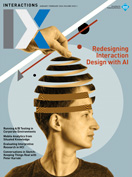Authors:
Elizabeth Churchill, Mikael Wiberg
Welcome to the January—February issue of Interactions! Taking a moment, we've been thinking about the "new year" and the idea of shared time and calendaring—and about how so much of our lives is managed by various kinds of calendars. When it comes to the year, now 2024, we are working on the globally recognized Gregorian calendar, introduced in 1582 by Pope Gregory XIII. Its broad adoption over centuries was transformative for global communication and trade; it promoted standardization, reducing confusion and inconsistencies when it came to arranging meetings, agreeing on timelines and deadlines, and orchestrating multichannel and multi- stakeholder trade negotiations. Its adoption was particularly important for the Catholic Church, for whom maintaining the accuracy of the date of Easter was paramount. The Gregorian calendar has had a lasting impact on history, science, and global affairs, providing a more accurate framework for recording events and tracking the passage of time, an essential factor for historical research and scientific studies. Can you imagine the extra work involved in scheduling research studies or organizing conferences without an agreed calendar?
Which brings us to this issue of Interactions.
While we have taken a number of things for granted in HCI/IxD over the past few decades, including a focus on human-centered design, human activities and labor, and ways of designing interactive tools for people, some of these ideas are now being challenged as we move toward completely entangled human-AI relationships. In that vein, kicking off 2024, our cover story foregrounds discussion on human-AI relations by focusing on the value of AI approaches and techniques. As of January 2024, we have all endured almost a year of marketing, as well as research and engineering advances, in AI approaches. Scholars and practitioners of HCI, IxD, and UX have been busy considering if and how we need to "rebrand" ourselves, exploring potential changes in our thinking about our domain and in our daily practice. Our cover story this issue, authored by Albrecht Schmidt, Passant Elagroudy, Fiona Draxler, Frauke Kreuter, and Robin Welsch, addresses whether large language models (LLMs) and generative AI will change the way we design and implement interactive systems. Reminding us that human-centered design (HCD) puts the human at the center of interactive systems design, the authors pose several questions, including: Can we use AI techniques and conduct HCD explorations without actively including people in the process? And would such approaches still be considered HCD? Through examples, they explore these questions and leave us with food for thought about the changing nature of HCD, UX, and HCI in the era of AI and LLMs.
In addition to our cover story, we have a feature article from Wei Xu and Zaifeng Gao exploring frameworks for human-AI teaming (HAT) as a new design paradigm. They propose a conceptual framework of human-AI joint cognitive systems (HAIJCS) and offer a summary of how to evaluate the nature of the human-AI relationship.
Neven ElSayed, Eduardo Veas, and Dieter Schmalstieg use a comic book format to explore a speculative design scenario around readily available, personalized, on-the-go mobile analytics. Thinking beyond steps counted by the sensors on your watch or phone, the authors explore how augmented reality in real-world settings could help people interact with analytics that count, quantify, and reflect their personal activities and behaviors.
In her first column for Interactions, Jie Li walks us through the pros and cons of A/B testing in corporate contexts. She reminds us that, while we think of A/B testing as part of our digital landscape of everyday interaction, such tests have been conducted in many contexts over decades. Local supermarkets and department stores run what are essentially A/B tests; for example, Li writes, "they might rearrange popular products at the entrance or back of stores, or change the direction of escalators to evaluate which variation optimizes customer shopping flows or generates more sales"—that is, what we in the online app and service world call engagement.
Finally, our Exit offering returns to the core, most highly valued items on the Internet: cats! In their exploratory art-meets-science work, researchers at the University of Nottingham and artist collective Blast Theory have created a space for cats (yes, real cats that purr) where AI is in the service of entertaining and creating an ideal play environment for cats. According to Blast Theory, Cat Royale is "a utopia where cats live in harmony with artificial intelligence," including an AI-backed robot that plays with them.
We hope you enjoy this issue of Interactions! As always, we invite you to consider submitting to the magazine.
Elizabeth Churchill and Mikael Wiberg
[email protected]
Copyright held by authors
The Digital Library is published by the Association for Computing Machinery. Copyright © 2024 ACM, Inc.








Post Comment
No Comments Found